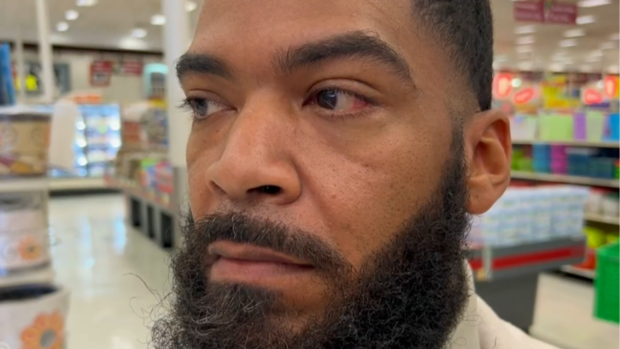“Agoraphobia is a prison”: Man confronts anxiety disorder that has restricted his life to one mile from his home
[ad_1]
Agoraphobia has gripped Cecil Jackson’s life since he was 19 years old. He’s one of an estimated 2 million adults in the United States who have the anxiety disorder that causes them to stay home to avoid situations that could cause a panic attack – like traveling or going too far away from home.
“I have been colorfully living and silently suffering for years,” Jackson said.
Jackson has missed family weddings, birthdays and even funerals because of agoraphobia. He has restricted his life to one mile from his home — living across the street from his job and a grocery store.
“For me, agoraphobia is a prison,” he said.
Recently, Jackson watched the “CBS Mornings” story about longtime anchor Karen Swensen stepping away from her TV career after overcoming a series of tragedies. Jackson said it was that story that caused him to take a clearer look at his own struggles and reach out to “CBS Mornings” lead national correspondent David Begnaud, asking Begnaud to be with him as he broke his boundaries.
“That was so powerful. I’m a 35-year-old Houstonian, and I suffer from agoraphobia. I seemingly lead a normal life as a local store manager, but no one knows that I haven’t traveled beyond a one-mile radius from my home in over 10 years,” Jackson told Begnaud.
Jackson’s late mother also suffered from agorophobia, but he never imagined it would happen to him, too. His symptoms first appeared when he was driving on the freeway, headed to school, on a sunny day.
At first, he said, his heart began racing, his arms felt weak and he felt lightheaded. Jackson said he tried to ignore those symptoms, hoping it was something like hunger, but he was also having breathing issues and his vision became distorted. That’s when he started experiencing depersonalization, in which things “don’t appear to be real,” Jackson said.
“Eventually, I went into a complete panic,” he said.
“That morning, I thought I had the world at my feet,” he said. “Hours later, the way that I viewed the world, the way that I viewed life had completely changed.”
Jackson said the best way to describe agorophobia is feeling like he’s living in a glass box — “like there are walls and boundaries that I cannot get past. And if I attempt to, or when I do, I literally feel as though I’m going to die.”
In 2016, he found Dr. Karen Cassiday, the owner of the Anxiety Treatment Center of Greater Chicago. Throughout the years, Cassiday not only responded to him. She also arranged for a local therapist to treat him with a session held online.
This past year, Jackson said he has accelerated steps to recover. He has lost 90 pounds in seven months by going meatless and giving up soda.
CBS News arranged for Cassiday to fly to Houston to help guide Jackson as he confronted places and conditions.
Jackson had a list of goals he wanted to get done during their meeting, including going to his therapist’s office, going to the grocery store and riding an elevator — something he hasn’t done in four years.
“The last time I attempted to get on one, or got on one, I jumped off,” he said. “So I kept trying to get on, but it got so overwhelming. I just said whatever’s up there, I won’t see today.”
The two embarked on the escalator together, Cassiday coaching Jackson every step of the way.
“I want you to reframe the anxiety to say ‘This means I’m doing something really good. This means I’m actually successful. I’m bringing it on,'” said Cassiday.
He would ride up and down four times, relying on exercises to induce dizziness to make it through. It was not soon after that Jackson noticed that the exercises were working.
“The sweaty palms, the dizziness, the sensitivity to light, I think I stood there for like three minutes talking to her… and it just subsided,” Jackson said.
One of those exercises is a rapid breathing technique known as hyperventilation, in which Cassiday would intentionally provoke Jackson’s anxiety. That is done to get him used to the sensation of panic and learn that he can handle it and teach his body to not respond with panic attacks, she said.
“I want to give you practice recovering from a panic attack so that you discover you can do it,” Cassiday told him. “You don’t have to be afraid of it. And even if the next time you go to your therapist’s office it’s the worst traffic jam ever, I want you to feel confident that you’re going to get there.”
For the first time in years, Jackson took an escalator by himself. He didn’t just stop there: Together with Cassiday, he went to a grocery store for the first time in years.
“It’s amazing to be here,” Jackson said as he slowly walked through the aisles.
He seemed quiet but not visibly nervous. But he managed to get through the cashier by himself and was all smiles as he walked out of the store moments later and high-fived Cassiday.
Jackson also ran outside his apartment complex for the first time ever and went to his therapist’s office for a face-to-face appointment — a step toward his future treatments.
He said he wanted to share his road to recovery to help others suffering from mental illness — but also to “be seen.”
“Initially I thought that in telling my story that I needed to be in a place where I was recovered. You know, ‘Let me be recovered so that everybody will see, you know, what it looks like at the end of the road,'” Jackson said.
“I think that sometimes when you suffer, you feel like nobody sees you,” he said. “And when you deal with agoraphobia, people write you off, and you’re often hidden in the shadows. I hope that others feel seen by me sharing this message.”
[ad_2]
Source link













